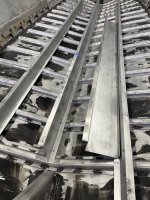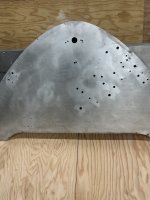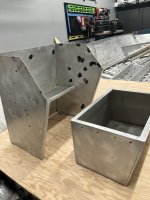Just a quick update and sorry for the lack of pictures. Nothing much interesting at the moment.
Got my steering measured up and ordered, sticking with the same NFB 4.2 system I used on my SS.
After a little sticker shock on some of the shipping charges for the Shields 149 livewell/bilge hose, I was able to source some by the foot at a local marina. 3/4" for the livewell fill and bilge pump, 1-1/8" for the livewell drain.
Splurged on the marelon 1-1/8" thru hull fitting for below the water line, although I probably would have been just fine with the standard nylon/plastic ones. I skipped on the seacock or ball valve, recognizing I won't likely be on any big water and the marelon fitting and quality hose are much less likely to present any issues.
Seats/cushions have been all stripped down and maintained for templates for the new seat covers. New plywood bases cut, along with all new bow supports, dash, etc.
Decking all cut and fit into place with the Nautolex on hand and standing by. Leaning toward a continuous run with the countersunk/hidden deck rivets rather than individual wrapped deck sections. Plan to strategically place 6-8" pry out deck plates under the console, helm seat, etc. to provide future access to any underdeck fittings, cable runs, etc.
Transom all fit into place and all thru holes drilled out. Was a bit more complex than my previous builds with the way this MR splashwell also skins/covers the inside of the transom and wraps over the top. Pretty happy with how all the holes lined up. Used some left over chunks of the glued up transom ply (1-1/2") to make a drill template for different bit sizes and keep everything at a nice 90 degree angle against the transom. Also got the exterior aluminum transom skin/motor pad all fitted and drilled. Still debating on best method for attachment - before or after paint, 5200 vs other epoxy, etc. Plenty of thru bolts to hold the final product in place, just overthinking what the best attachment method would be to prevent any water entrapment between the two sheets of aluminum and potential corrosion issues.
Weather looks to be warming here in MN next week, so hoping for some opportunity to get the hose back out, do a quick leak test, and maybe even lay down some paint.
Slowly, but surely...























